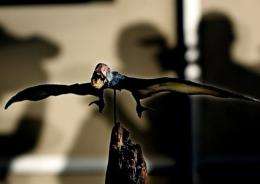Terrifying pterosaurs were fragile in flight

Pterosaurs, the largest creatures ever to take to the skies, were adept fliers in a balmy breeze but would have crashed in stormy weather, according to a study published Wednesday.
Evolutionary biologists have long puzzled over the aerodynamic abilities of the giant reptiles, which cohabited the planet with dinosaurs during the Mesozoic era 220 to 65 million years ago.
A few scientists have even suggested that pterosaurs, also known as pterodactyls, probably couldn't fly at all.
With a wingspan of up to 12 metres (39 feet) and weighing up to 200 kilos (440 pounds), just getting airborne was surely a challenge.
But engineer-cum-palaeontologist Colin Palmer at the University of Bristol in Britain has shown in wind-tunnel experiments that the prehistoric beasts were in fact stunningly adapted for certain types of flight.
Using curved sheets composed of epoxy resin and carbon fibre, Palmer constructed models of pterosaur wing sections based on fossil records.
Recent experiments on low-speed airfoils and sail boats provided clues on how the animal's sail-like wings might have functioned.
Then he tested the strength and aerodynamic properties of the mock appendages in a wind tunnel, much as a flight engineer might assess designs for an airplane wing.
What he found was that the animals were best suited for flying smoothly over hillsides and coastlines on gentle thermals, or warm air currents.
Slow flight and the variable geometry of their wings also enabled them to perform soft landings, reducing the risk of breaking their fragile bones.
"Since the bones of the pterosaurs were thin-walled and thus highly susceptible to impact damage, the low-speed landing capability would have made an important contribution to avoiding injury," Palmer said.
The tests also showed, however, that powerful gusts would almost certainly have sent the creatures plummeting to Earth.
"The tradeoff would have been an extreme vulnerability to strong and turbulent winds both in flight and on the ground, like that experienced by modern-day paragliders," Palmer noted.
The study was published in the Royal Society B: Biological Sciences, a journal of Britain's de-facto academy of science.
(c) 2010 AFP




















